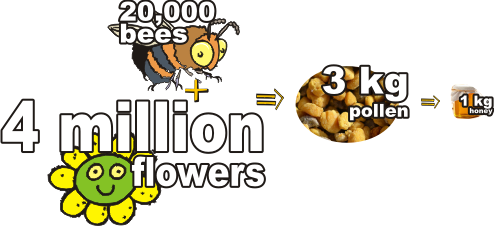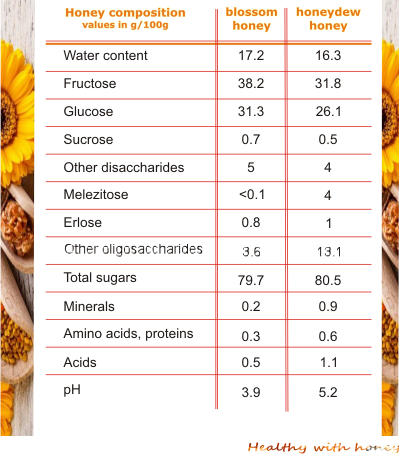Honey is a sweet food made by bees from the flowers’ nectar or honeydew droplets. It is the only food that includes all the substances necessary to sustain life, including enzymes, vitamins, minerals, and water and even more, it’s the only food that contains pinocembrin, an antioxidant associated with improved brain functioning.
Honey is also the only food that doesn’t spoil. It was found in Tutankhamun’s tomb, ans it was still edible. It crystallizes in couple of months after harvest, but this is a natural process and it doesn’t alter its properties.
Honey bees collect the nectar from blossoms and put it in their special stomach. On the way back to the hive, they add invertase, an enzyme synthesized by the body of bee, and other digestive acids. They ingest and regurgitate the nectar many times, until it is partially digested. The bees work together as a group, and do the regurgitation and digestion until the product reaches a certain quality. Then the bees store the honey in honeycomb cells and left them unsealed.
The resulted honey is still very high in water and natural yeasts, but the bees don’t let it to ferment. They fan their wings and create a strong draft across the honeycomb, which enhances evaporation of water from the nectar. This evaporation raises the sugar concentration and prevents fermentation. The honeycomb cells are then sealed.
The bees produce honey as a food and energy source during winter or cold weather when fresh food is hard to find. Beekeepers harvest the honey in autumn, leaving enough for bees to survive during winter.
On short, this is how is done:
The hive
The most synchronized and synergetic society, the bees are the musketeers of the hive, they are “all for one and one for all”! It’s a feminist society as most of the colony is made of females. The hive gathers three types of bees:
 1. One queen (which is larger than a regular bee)
1. One queen (which is larger than a regular bee)
2. 300 to 3,000 male bees (also called drones) which don’t work, in fact they don’t do anything, exist only to fertilize new queens.
3. 20,000 to 40,000 female worker bees.
The queen mates with several males, only once, and after that they are able to lay 2000 eggs daily. They can be fertilized eggs which will turn into worker bees unable to reproduce, and unfertilized eggs which will turn into males, which will be on stand-bye the whole summer, for mating a virgin queen, and then dying (with dignity!). The others are simply expelled from the hive during winter. And they don’t even possess a stinger. Quite Amazons those ladies!
Are there vitamins in honey? Er, NO?!
What are the enzymes present in raw honey? Why are they important?
Natural antioxidants in honey. Do we really need antioxidant supplements?
Why is honey so valuable? What are polyphenols and what are they good for?
What gives honey its antimicrobial power?
Honey composition
Honey is a supersaturated solution of sugars, mainly composed of fructose and glucose, and water, but also minerals, vitamins, free aminoacids, enzymes and polyphenols. Fructose and glucose are monosaccharides, that is, simple sugars. Sucrose, is composed of fructose and glucose linked together, is a disaccharide and it comprises a little over 1% of the composition of honey.
The glycemic index ranges from 31 to 78, depending on the variety, the density is of about 1.36 kilograms per litre.
Organic acids comprise most of the acids in honey, accounting for 0.17–1.17% of the mixture. Gluconic acid is the most prevalent. The other organic acids are in minor concentration: formic, acetic, butyric, citric, lactic, malic, pyroglutamic, propionic, valeric, capronic, palmitic, and succinic, and many others.
 The amino acids are up to 18 (of the 20) and
The amino acids are up to 18 (of the 20) and
are derived almost solely from the bodies of the bees. However, amino acid content is almost negligible in honey, only 0.05–0.1% of the composition. The main amino acid is proline.
Endospores: Honey is antimicrobial in its “natural’ state. It’s about 17% water and the sugars chemically tie up the moisture, keeping wild yeast and bacteria from using it. Without ready-to-use moisture, the spores of yeast remain dormant, and an adult digestive system will not have any kind of problem. Nevertheless infants have an immature intestinal track and cannot face the endospores of the bacterium Clostridium botulinum which can lead to illness and even death. This is the reason infants should not be given honey. The composition of honey depends a lot on the flowers the bees visit to produced it.
There are many types of honey, classified after different parameters.
Is honey sweeter than sugar?
Slightly sweeter.
From the three most important sugars in honey, fructose is slightly sweeter than sucrose, glucose is less sweet, and maltose even less sweet. In most honeys, fructose predominates and tends to make honey taste slightly sweeter than sugar. Some honeys which are very rich in fructose tend to taste very sweet, but there are a few types of honeys which contain more glucose than fructose.
There are 14 sugars in honey. One of them is called Melazitose. It does not come from honey bees or plants. Aphids use their tongues to pierce plants to bring up the sweet sap and ingest the liquid. Ants carry off the feces. Honey bees also use the feces to make what is known as Honeydew. While Americans are not very familiar with this type of honey, Germans love honeydew honey more than any other.
On the average, honey is 1 to 1.5 times sweeter (on a dry weight basis) than sugar. Liquid honey is approximately as sweet as sugar, yet it contains only 82.4 g carbohydrates/100 g (vs. 100 g for sucrose) and provides only 304 Kcal/100 g (vs. 400 Kcal for sucrose). And yes, diabetics can eat honey, it is even recommended.
One tablespoon of honey weighs 21 grams and has approximately 17 grams carbohydrates and 64 calories (kcal).
DO you want to know how honey is made? Watch this video.
************
References:
http://en.wikipedia.org/wiki/Honey#Indicators_of_quality
http://www.honey.com/images/downloads/carb.pdf
picture source: Wikimedia commons
Anna Verdica via flickr.com

I’ve heard about Thai honey. Are you selling it?
I like honey. There is not enough more information about this.
True, Nata, that is why I have created this website and that is why I’m trying to gather as much info as possible. People must know that honey is not only sugars, not only a treat, but also medicine.
Thanks for stopping by.
Laura
My grandfather loved honey. I like your website.
So did my Grandfather, Zura. 🙂 Maybe my passion comes from him.
Laura
Good afternoon. I love honey. I especially like morning sandwiches with it. Thank you for the detailed information on your website.
I’ve just come across some carob honey (Portugese Alfarroba da Serra) and thought I might find out more about it on your site, but it’s not listed. Do you have any information about this particular honey?
Sounds wonderful. I will soon write about carob honey as well. Have you tried it? Did you like it? 🙂
Laura
Later Edit: The article with carob honey is here: What is carob honey? A powerful antioxidant chocolate treat!
I love your site, the pictures are lovely and the information very useful. I definitely love honey. It is one of my favorite cooking ingredients and yes, I also use it as a natural remedy for many health conditions. I have also heard that is is a wonderful afrodisiac…is it true? 😉
Blessings!
Hilda
Hi Hilda,
Well, I did found this info on the web, too, but no study, no official report to confirm it. Yet, it may be true, a disease, better said, an imbalance, can have so many causes, and honey does help with so many, that it can be true after all. By healing a deeper cause of this imbalance, we can obtain an improvement in our sexual life.
Nevertheless, there are two other things connected to this, beauty and fertility, and honey does help with both.
Blessings to you, too!
Laura
So funny the male bees are lazy bums that sit there while the females do all the work hehehe
I will put a new page about the life in the hive. But you know, these males, don’t do anything at all. Stay in the hive, eat honey that females make and from time to time get outside the hive to stretch their wings.
But their life ends quickly: either after mating the queen, or in autumn when they will be kicked out of the hive, and eventually die of cold and starvation. From a super life to a miserable one. Everything in balance. 🙂
Hi Laura,
What a wonderful site. I recommend local natural honey to all my patients with allergies. You got a great start! Keep blogging and you will do great.
For allergies, small quantities of fresh pollen have a better result. For those that can find fresh pollen and keep it in the freezer.
Thanks for the good words.
laura
Hi Laura,
Your site is so informative, and gorgeous! Keep up the good work, and thanks for sharing your love with us!
🙂 Thank you, David.
I absolutely love your site. I have learned so much about honey (and bees) just by being here for a few minutes.
Thank you,
laura